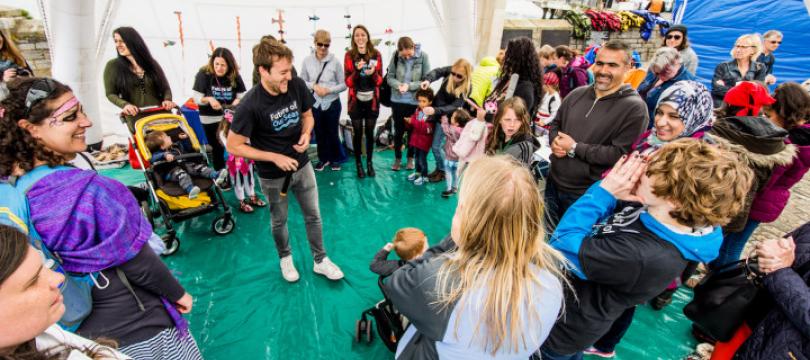High Quality Engagement 101
- High quality engagement framework
- Introduction to High Quality Public Engagement
- The framework in practice
- What purposes do you have for your engagement work?
- Who might you involve or engage with?
- What methods could you use?
- What are the measures that this project was a success?
- Pause for thought
- Get inspired!
This page offers an in-depth practical tutorial on how to apply the key principles of quality engagement to your work. There are several stages to work through so we suggest you complete them over time, returning to work through each section as you develop your engagement plan.
High quality engagement framework
The NCCPE has identified four principles which, when considered together, can help you achieve high quality projects across all forms of engagement, no matter their scope and scale. The high quality framework principles are purpose, people, process and evaluation.
In the following video Co-Director of the NCCPE, Sophie Duncan, explores these principles in detail.
Introduction to High Quality Public Engagement
You can use the four principles to help you plan your engagement project. It is also important to return to these principles as you develop and deliver your project to ask:
- Is your project meeting the purpose you set out?
- Are there additional people that should (or shouldn’t) be involved, as people you are engaging with, or stakeholders and intermediaries?
- Are your processes fit for purpose?
- What improvements could/should you make?
The framework in practice
So how can you put the framework to use to plan your own engagement activity? We have included some key questions and resources to help you plan your approach and illustrated it with a case study to show how these principles can be applied in practice. As you go through this section, use the following template to plan a potential engagment activity of your own.
What purposes do you have for your engagement work?
Having a clear idea of the purpose of your work, and the outcomes or impacts you hope to achieve is important. There are some useful tools to help you think through the kinds of impacts that can be realised through engaging the public:
- NCCPE Impacts Framework: Describes three types of impacts: impacts on people, to stimulate curiosity, understanding and empathy; on communities and organisations, to build capacity and networks; or on policies and processes, to improve decision making and the way things work. Find this framework in the video above and accompanying slides.
- Generic learning outcomes framework: Considers the benefits you want people to gain through interacting with your project, categorised into skills; knowledge and understanding; enjoyment, inspiration and creativity; attitudes and values; and activity, behaviour and progression.
Case Study
The researcher considered a range of options for their engagement work including:
- To inspire the public about their research
- To encourage school children to recognise the impact of climate on coastal areas
- To share knowledge with local community members and get them excited to be part of the conservation effort
- To incorporate this research into the conservation management’s community programme
- To raise policy makers’ awareness of the impact of weather on such vegetation and the coastline to encourage other councils or regions to help tackle this conservation issue.
Considering the resources available and the value of encouraging more people to get involved in the conservation effort, the purpose the researcher initially chose was 'To share knowledge with local community members, motivate them and equip them to be part of the conservation effort in the area.'
Who might you involve or engage with?
There are lots of different people you may want to get involved in your engagement work including:
- Participants (individual members of the public, groups, organisations, etc.)
- Partners who can help develop and/or deliver the engagement activities
- Stakeholders who can help inform and/or fund the project
Understanding publics
Developing an understanding of the participants you seek to engage with helps ensure that your project is relevant and effective to their interests and needs. Audience segmentation can help. Some focus on demographic information (location, gender, socio-economic characteristics etc.); others classify people by their interests, attitudes, or behaviours. For example:
- AHRC Taking Part analyses audiences across demographics, behaviours, and location in different contexts: arts, heritage, museums and galleries, libraries, internet usage, social networking etc. It provides insights into how people behave in different contexts and who you can find in these spaces.
- Cultural dynamics framework looks at people’s values, providing ideas about why people behave the way they do and the ‘hooks’ to involve people whose values are very different to your own. Try the cultural dynamics quiz and see where your own values sit in this system.
- NERC Public Insight Research report, 2017 segments the UK public by behaviour, resulting in unique audience descriptors that incorporate factors such as interests, trust and preferred media outlets. Is there a particular behavioural segment best suited for your selected purpose?
Partners and stakeholders
Think of who else is working in this space and who else you could work with or align your work to, for example: schools, museums, community organisations, libraries, charities, cultural venues etc.
The hook
Don't assume poeple will care about your topic. When considering participants and partners ask why they might want to be involved and how you will hook their interest. Consider what you could do to make your approach more relevant, and how you will encourage them to get involved.
Case study
The researcher considered engaging with including students at the local schools, local business owners with a vested interest in the coastline, and walking clubs that use this outdoor space. However, given the proximity of two secondary schools to the site, the researcher chooses to target 11–14-year-old school students and their families, to increase the involvement of the local community, and make important connections across the area.
The researcher approaches the two local schools, and in discussion with the teachers, agrees to work with two afterschool clubs focused on the environment. They also agree to work with the conservation charity responsible for the site, to inform the approach and ensure that the participants can get involved in conservation programmes run by the charity. The charity is delighted to develop stronger links to the schools, the students and their families.
What methods could you use?
It's easy to think of methods first when developing an engagement project before thinking through why the project is important and who might be interested. Clarity on the why and the who helps ensure you develop an approach that works well.
The chosen methods need to fit with your purpose and the people you hope to engage with, as well as the skills or capacity you (and your team) have, and you don’t have to go it alone. You could get involved in other’s events, such as a festival or outreach day.
Once you have decided your approach, it is time to develop the project scope, taking into consideration ethical and social issues, budget, marketing, and project management.
Case study
The researcher is exploring potential interventions to stop density loss through extreme weather events. They want to involve the students in the research and agree with the two schools to run a term’s worth of activity for their afterschool clubs. Students will be collaborators, researching ideas for interventions amongst their families and friends; getting involved in data collection through doing surveys at the research site; and sharing the research outcomes by running an event for the local community to share what they have learnt. The conservation charity will provide field workers to support the students and offer options for people to sign up as volunteers at the community open day.
What are the measures that this project was a success?
Finally – it is really important to think about how you can evaluate your project. Evaluation provides an opportunity to test out ideas before you put them into practice, review your approach, as well as assess if and how it is working.
Case study
The researcher worked with the afterschool club lead teachers, two student representatives, and the conservation charity to agree a set of outcomes from the project.
- Students and their families gain an understanding of research into coastal erosion, and how it can be mitigated.
- Students and their families increase their interest in conserving the coastline, and some commit to volunteering for the local conservation charity.
- Conservation charity gains insights into how the research undertaken can inform their work.
This process strengthened the relationship between the schools, the researcher, and the conservation charity. A few different evaluation methods were used to evaluate this work.
- Survey: pre and post surveys were used to quantify knowledge, confidence and interest in the project (from students, families, and community members).
- Interactive feedback: at the final event, feedback walls captured participant views on post-it notes.
- Focus groups: 3 months after the project, two focus groups were held with students involved in the project. Run as part of the afterschool club, the focus groups explored what students and their families had done since the project, and ideas for future work.
Pause for thought
Clearly our case study is only one example of what could be done. However, by using the prompts in the high quality engagement framework, the researcher was able to develop an approach that was right for the research, the participants, and the partners.
Get inspired!
We have selected three case studies that exemplify high-quality engagement, from one-off local events to international endeavours. Explore how cookery classes supported people affected by macular degeneration, an undersea choir showcased the impact of noise pollution in our oceans, and research on the lived experience of climate change in Dhaka was shared through local theatre.
Check out the case studies in this short video, or read the accounts below.


